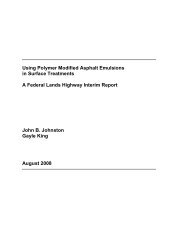Handbook for Bridge Inspections - TSP2
Handbook for Bridge Inspections - TSP2
Handbook for Bridge Inspections - TSP2
You also want an ePaper? Increase the reach of your titles
YUMPU automatically turns print PDFs into web optimized ePapers that Google loves.
Superstructure<br />
Surfaces most exposed<br />
t o Chloride Penetration<br />
Surfaces least exposed<br />
to Chloride Pene tratio n<br />
Chloride and Mo isture<br />
Combination of<br />
Materia ls Testing<br />
Leeward facing surfaces low down and near the water surface,<br />
especially large cross·sections, <strong>for</strong> example pil lars of Cantil ever<br />
<strong>Bridge</strong>s;also the underneath of bottom plates, cross girders and<br />
beams.<br />
The windward sides of sl im superstructures with a hi gh elevation<br />
above sea· level.<br />
Concrete surfaces containing a high level of chloride will retain<br />
moisture longer during the drying out process and will consequently<br />
be of a darker shade than surfaces with a low salt content.<br />
It is there<strong>for</strong>e possible in a damp coastal cl imate to see with the<br />
naked eye which surfaces have most been affected by chloride.<br />
Surfaces greatly subject to wind and rain (on the windward side)<br />
will gradually acquire a sandy appearance because the top surface<br />
layer of the concrete will have been washed away.<br />
When deciding the places to undertake materials testing one<br />
should make use of this knowledge of chloride instigated stress.<br />
It is important to carry out several kinds of materials testing, e.g.<br />
surface cover measurements, chloride analyses, ECP measurements,<br />
cutting open the concrete, in such a way that these can be<br />
compared wi th one another be<strong>for</strong>e the condition of the concrete is<br />
decided on. Materials testing should also be viewed in relationship<br />
to any visual inspections undertaken.<br />
in order 10 be able to compare the result's of materials testing such<br />
as surface cover and ECP measurements, measuring the chloride<br />
content and the depth of carbonisation, and cutting open the concrete,<br />
they must all be carried out at the same places. Refer to<br />
Chapter 8.5 <strong>for</strong> a presentation of materials testing <strong>for</strong> concrete.<br />
7.4 Adequate Materials<br />
Testing - Steel<br />
In the following section a description wi ll be given of the possible<br />
materials testing <strong>for</strong> use in inspections of bridge sib ridge elements<br />
made of steel.<br />
Purpose<br />
Procedures<br />
7.4.1 Checking the Torque of Screws<br />
To check the stud torque of screws in friction joints.<br />
Checking the torque of screws may be necessary in connection<br />
with acceptance inspections if this has not already been carried out<br />
during the construction phase. Reference is made to the National<br />
Public Roads Admini stration Manual No. ISO: '<strong>Bridge</strong>s - Safety<br />
and Technical Standards', Point NO.7.
















